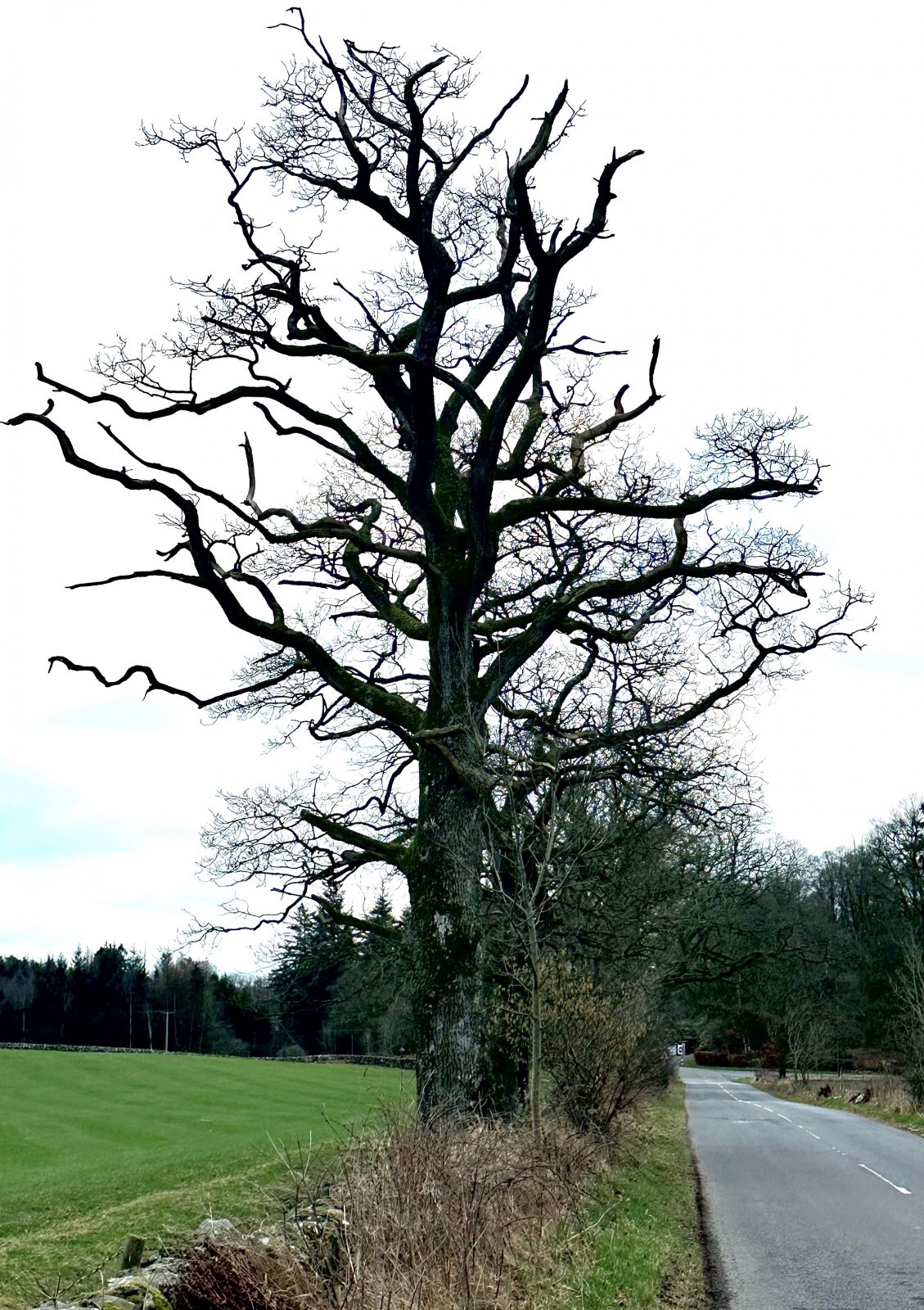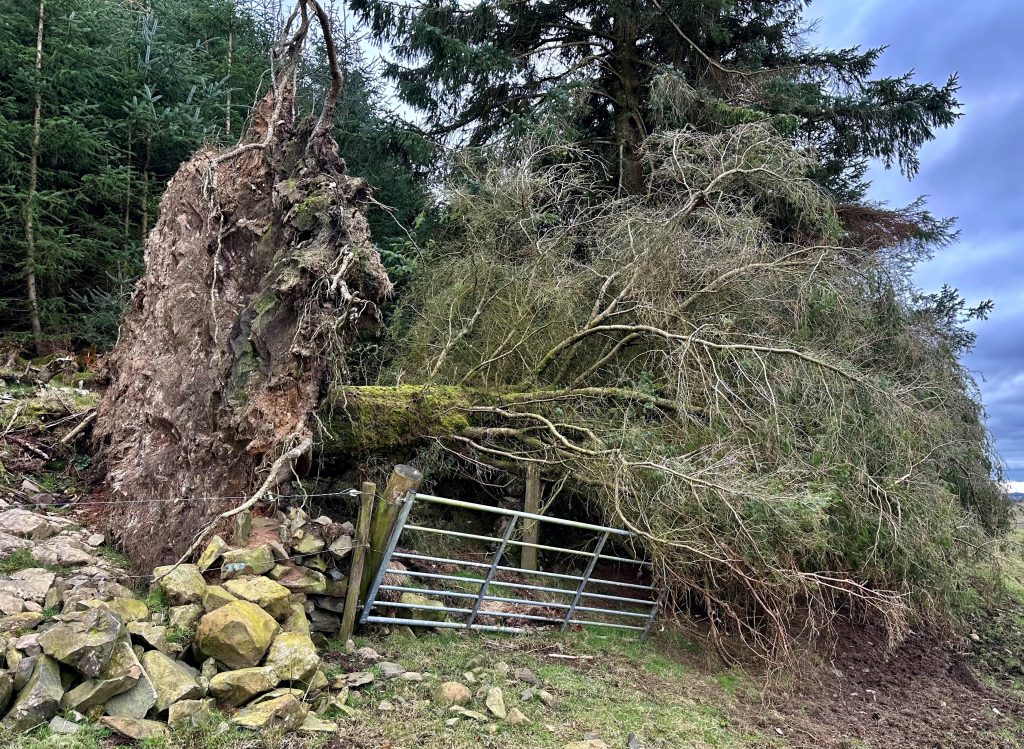
By Keith Muir, Head of Forestry at Davidson & Robertson
There have been severe storms for the last three years – some quite recent, so you don’t have to travel far to see fallen trees. Landowners have a responsibility to maintain the trees on their land and they are liable if something goes wrong. By law, landowners should be aware of the risks associated with their trees, but how many landowners have processes in place for tree inspections? The cost of not carrying out this duty of care could be high as recent fines have proved to be many thousands.
“Newcastle City Council has recently been fined £280,000 due to the tragic death of a six-year-old girl, who died at school after being struck by a falling tree. Another Borough Council was fined £100,000 for failures which saw a tree branch fall and strike a pregnant woman, leading to the death of her baby daughter.”
Trees bring us joy, clean air, and lots of biodiversity, no one can really dispute this, but they can also bring landowners a lot of responsibilities and liability. We read of very large fines for councils and large companies who have not carried out their duty of care when it relates to trees, especially around urban environments where the risks are high. So how does this relate to farms and estates in the countryside?
We have had three years of large storms and serious damage. One would be forgiven for thinking that any risky trees are already flat on the ground and out of harm’s way, but this is not the case.
Any landowner that owns trees has a duty of care for them and anyone or thing that could be harmed by the tree(s). The bigger the landholding, the more the landowner is bound to either gain knowledge or buy in knowledge on how to manage the trees and the associated risk. This makes it especially essential that estates and farms with mature veteran tress along miles of country roads, or backing onto houses or paths, fully understand their legal duty of care.
Legal duty of care
Under law it is expected that landowners should be aware of the risk associated with trees, and if they’re not, they should find someone who is and ensure that some sort of inspection system is created and followed. This does not stop trees falling. However, should that tree fall over and hurt someone, or something, and it came to light that the tree had not been inspected, and potentially had signs of deterioration, then that opens the door to a lot more questions.
Felling licences will apply
It is worth noting at this point that you cannot fell trees without prior permission. There is an exemption that allows up to 5 cubic meters of timber each quarter (1st Jan to 1st April is the 1st Quarter) and of that, only a maximum of 2 cubic meters can be sold as a product. Anything more than 5 cubic metres requires a felling licence.
The rules around felling licences, particularly in England, have been tightened in recent months, so it is worth taking advice on what is required. In England, illegal tree felling now comes with the potential of unlimited fines, whereas in Scotland it is £5,000. That said dangerous trees can be felled out with a licence, but other checks will apply.
There are slight differences in Scotland and England, and just because a tree has fallen over, it does not necessarily mean that it is safe to remove it. Trained professionals will be able to guide you through the rules and regulations to ensure compliance. In all cases take evidence via emails, notes and photos before trees are removed – is the advice.
Setting up a tree inspection system
Setting a up a tree inspection system is not difficult. It will cost time, money and potentially create more work – especially short term, so why, when landowners or tenants are strapped for cash, should they create such a system?
Simply put it will save you money and potentially prevent severe court fines if found guilty. It can also provide a source of fuel, or even a product you can sell and make money from – if the timber is in reasonable condition.
Leaving that dead tree at the side of the road for the past year is not a sign of good management. It is not the council’s responsibility to deal with, if it’s in a field or woodland, it is the landowners responsibility.
“If the courts find that negligence is involved, the fines can be hundreds of thousands of pounds.”
If you set up a system you are demonstrating competence and good land management. The system will create zones based on the risks associated with the location and type of tree matched against the potential damage to property or persons. It will define the frequency of inspections and what work is required as an outcome of the inspection. All this builds a body of evidence that, should a disaster strike, will help mitigate any court findings and put it down to natural events not negligence.
Setting up tree inspections come with a word of caution. If a system is created and then is not followed, the same high fines can prevail and sometimes be higher due to the fact that a system was established and then ignored. Setting up and maintaining tree inspections need not cost the earth.
Training for in-house inspections
Getting an estate or farm worker trained to carry out a basic tree inspection will cost around £170 and means they are also fully certified via Lantra. This would allow inspections to be done in-house and be held up as being legitimate. Basic Inspections should be able to identify major issues that are easy to observe such as dead limbs, poor leaf cover & dead trees.
Basic tree inspections are unlikely and don’t really cover more hidden issues such as cracks in limbs or rotting in older trees, for that, a professional tree inspection is required by highly trained specialists – normally arborists, who can climb trees and give a full report as well as identify disease. From the inspections a work program is created, and the work carried out. All this inspection activity is evidenced via records and builds up proof of competence.
At Davidson & Robertson, our forestry department has built up that experience and knowledge and can facilitate the creation and management of such systems. We also help landowners build their own systems and develop the necessary skills to conduct this vitally important land management requirement.
Don’t get caught out! Tree inspections should be seen as value for money – especially when you consider the risks and potential fines attached. The more cases that hit the media, the harder it is to ignore the issue and the more expensive it becomes should it go wrong.
If you have a Forestry Advisor, ask about tree surveys and your potential risk and then mange it accordingly. If you don’t have that specialist support, or are unclear about any advice you have been given, call the D&R Forestry Team on 01556 502270 or Keith Muir, Head of Forestry on 07379 49517



